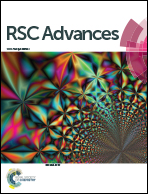Thermally reversible solidification of novel ionic liquid [im]HSO4 by self-nucleated rapid crystallization: investigations of ionic conductivity, thermal properties, and catalytic activity†
Abstract
In recent years, the growing concern for the environment has triggered the search for new materials that meet the criteria for the preservation of natural habitats. Among these materials are ionic liquids, the new generation of which has contributed substantially to the rapid development of green chemistry. In this paper, we report the synthesis and characterization of an ionic liquid of imidazolium hydrogen sulphate ([im]HSO4), which displays multifunctional properties. The [im]HSO4 ionic liquid can be used either as an efficient catalyst in the preparation of hexahydroquinolines under green conditions or as a thermally reversible ionogel. Investigations of its catalytic properties showed that [im]HSO4 can be reused at least four times without appreciable loss of activity, and the reaction yields are in the range of 92% to 98% referred to the isolated pure products. On the other hand, the ionogels formed by [im]HSO4 showed high ionic conductivity (up to 25 mS cm−1 in the solid phase) and melting points of approximately 54 °C. The process responsible for gelation was found to be solidification by self-nucleated crystallization. The structure of [im]HSO4 was fully characterized using FT-IR, 1H NMR, 13C NMR, XRD, SEM, TGA, and DTA. The physical properties important from an application point of view (e.g., ionic conductivity, thermal stability, phase transitions and microstructure) were investigated by thermal scanning conductometry (TSC), differential scanning calorimetry (DSC) and polarised optical microscopy (POM). The results of this work support the rational design, synthesis and application of task-specific ionic liquids for various purposes.
![Graphical abstract: Thermally reversible solidification of novel ionic liquid [im]HSO4 by self-nucleated rapid crystallization: investigations of ionic conductivity, thermal properties, and catalytic activity](/en/Image/Get?imageInfo.ImageType=GA&imageInfo.ImageIdentifier.ManuscriptID=C6RA21488F&imageInfo.ImageIdentifier.Year=2016)


 Please wait while we load your content...
Please wait while we load your content...